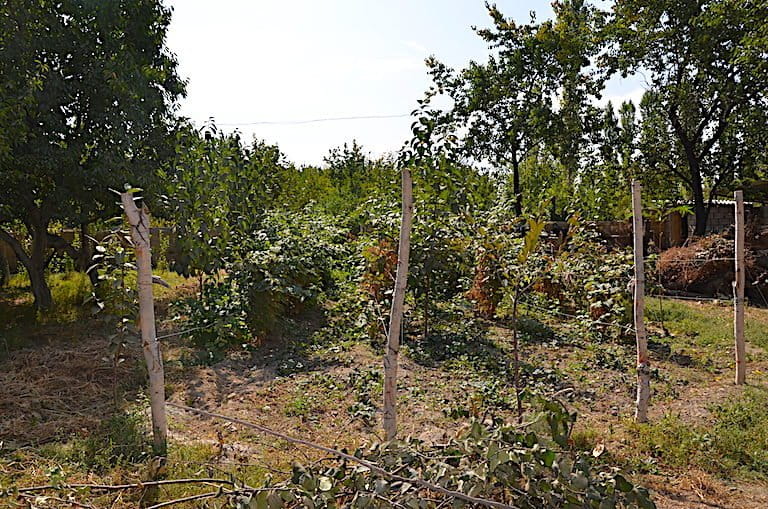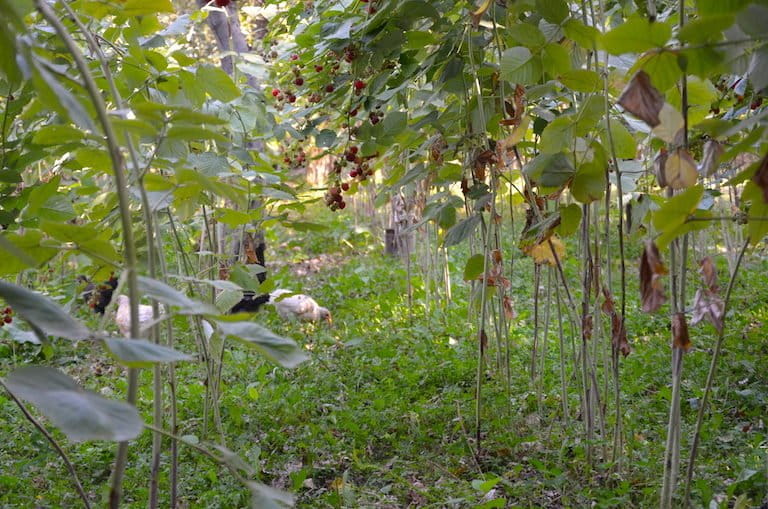- In the arid Kyrgyz border region of Batken, farmers grow agroforestry gardens of pomegranate, peach, apple, apricot, and cherry trees which provide shade and moisture to intercropped vegetables and low fruit crops like strawberry and raspberry.
- Because irrigation water is limited, agroforestry allows farmers to grow many crops in close proximity, rather than monocrops of grain or hay as one sees in neighboring areas.
- Farmers enjoy diverse harvests for a longer period of time each year, from Spring to Autumn, and their forest-mimicking gardens are home to biodiversity too, like hedgehogs, hares, and lynx.
- Agroforestry also captures carbon dioxide from the air and stores it in branches, trunks, and soil, making it a useful solution to climate change, one which also boosts soil horizons, groundwater levels, and biodiversity.
KOK-TALAA, Batken province, Kyrgyzstan — The Batken region is located in the southern part of the Fergana Valley, on Kyrgyzstan’s border with Uzbekistan. Like the rest of Kyrgyzstan, much of its territory is mountainous, so the amount of land suitable for human settlement is small.
The village of Kok-Talaa is located in the heart of Batken. It experiences soil-baking summers, so 80 percent of the land around it is planted with gardens; the lack of irrigation and drinking water means large croplands would wither. Since 1994, local farmers have reoriented from animal husbandry and cultivation of major agricultural crops to gardens based on the principles of agroforestry — a method of growing useful trees and bushes in combination with vegetables and fruits, where the taller plants shelter the shorter ones from the sun and provide soil moisture from their deep underground root systems.

Elsewhere in Kyrgyzstan, there is a moratorium on the transformation of lands like these to other uses, like the growing of trees. But this doesn’t apply to the Batken region.
“The case of Batken is a unique example of agroforestry in Kyrgyzstan. Since the Soviet period the local farmers specialized in growing fruit trees, especially the famous Batken apricot trees,” says Klara Dzhakypbekova, coordinator of the SUSWALFOOD Research Project, a program of the Rhine-Waal University of Applied Sciences in Germany. “The National Land Use legislation actually hinders the growth of trees on [these] irrigated land areas, as those are very limited and provide [the country’s] major share of crop products. But the border areas of the country are excluded from such regulations, and farmers are free to decide which land use options to use.
“The Batken lands are very arid [so] intercropping of fruit trees with crops and grains was selected by many farmers,” Dzhakypbekova adds. “One can observe such plots right after entering the first miles of the Batken region, which contrasts with vast pastures or monocrop fields of the neighboring region.”

Under the Kyrgyz system, each person is allocated a plot of land. Farmers seeking the maximum benefit from growing crops in the Batken area settled on agroforestry after some experimentation.
Imarali Balquev is one such farmer and also head of an agricultural cooperative with 15 members. He has several plots spanning a combined 4 hectares (10 acres), so he’s considered a large landowner. He grows several types of peach, cherry, apple, persimmon, plum, pomegranate and apricot trees that are resistant to drought. Thanks to mild winters and varying maturation periods for different trees and crops, Balquev can harvest from May through October.

“The climate is warm, everything ripens early and we begin to feed the whole of Kyrgyzstan with fresh potatoes, greens, fruits. Between the rows of fruit [trees] I plant potatoes, corn, onions, beans, clover, so I minimize costs and get a profit. The income from the harvest is enough for fieldwork, the education of children, to marry [off the] children, to build houses, for everyday expenses,” Balquev says. The cooperative has also invested in an industrial refrigerator, where its members can store their harvests and then sell in bulk.
Fieldwork doesn’t stop after the harvesting. In winter, any snow almost immediately melts, so farmers use that period for pruning and watering the trees. Any remaining ripe fruit is fed to domestic animals, taken to the cooperative’s canning shop to make juices and compotes, or dried.
Beside benefiting farmers, the older agroforestry gardens in remote areas provide homes and hunting grounds for many wild animals, like the long-eared hedgehog (Hemiechinus auritus) two kinds of foxes, Eurasian lynx (Lynx lynx), Tolai hare (Lepus tolai), peregrine falcon (Falco peregrinus), and several types of vultures.

Another farmer, Burgutov Kamaradin, has rented 15 hectares (37 acres) of rain-fed land in the hills. Three years ago he set up an agroforestry-based garden on 3 hectares (7.5 acres), and already his first harvest just this year has delivered 2 tons of peaches. He also grows quince, raspberry, plum and almond on this arid land now converted into blooming gardens.
A village that runs on raspberries
The nearby village of Orozbekov sits in an ancient lake bed, which gives it a microclimate that’s ideal for growing raspberries. There are some 300 households in the village, each with a plot of 800 square meters (8,600 square feet). From such tiny plots, locals can grow up to 600 kilograms (1,300 pounds) of raspberries for sale, in combination with apples, cherries, poplars, cabbages, tomatoes, potatoes and herbs. Pruned raspberry branches are used as fuel, and proceeds from the harvest pay for food, the children’s schooling, and clothing.

Farmer Inoyatkhon Nurdinova, while showing her plot, says, “After the collapse of the Soviet Union, [I was] one of the first who understood how profitable [it is] to grow raspberries. I destroyed my vegetable plot and planted it completely [with] raspberry [and] fruit. Now raspberries are grown [by] every family.”
Business has been good. “I have permanent dealers with whom I have worked for many years. They come and take it right out of the house. So I do not even need to leave the house to earn money,” Nurdinova says. But as with all farming, she adds, there are difficulties. “For example, two years in a row I could not get a harvest because of locust starlings [Acridotheres tristis].”
All that the inhabitants of these villages typically need to buy from the grocery store are vegetable oil, flour, salt and sugar; everything else they grow on their plots. Any surplus is sold fresh or dried, since fruits from this region are famous and often exported to Kazakhstan and Russia.

Despite the limited water resources, the farmers of Batken have succeeded by deciding to intercrop and use the land efficiently, agroforestry expert Dzhakypbekova says. “Batken is a unique example [of] how farmers are able to find the most efficient solutions themselves in case the right conditions are given. Intercropped fruit trees and berry bushes with crops like potato, pepper and tomatoes [are] the primary resources [for] family needs during winter.”
It’s proof that even in arid regions like this portion of western Kyrgyzstan, agroforestry can increase the food security and resilience of agricultural communities.
This article is part of an ongoing series on agroforestry worldwide, see all the features here.
FEEDBACK: Use this form to send a message to the author of this post.














